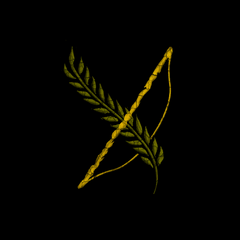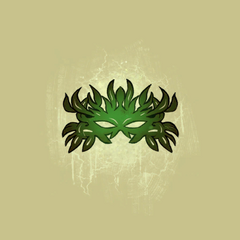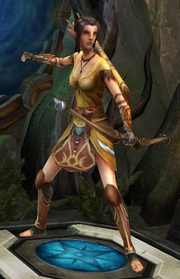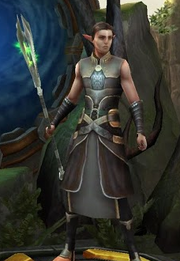- For the member of Bull's Chargers, see Dalish (character).
“We are the Dalish: keepers of the lost lore, walkers of the lonely path. We are the last of the Elvhenan, and never again shall we submit.” ―The Oath of the Dales
The Dalish are nomadic elves that seek to recover, inherit and preserve the knowledge and sacred treasures of the two fallen elven kingdoms, the Dales and Elvhenan. They lead nomadic lives, wandering throughout Thedas. Their clans date back to the independent kingdom of the Dales and the Dalish themselves are their descendants. Many Keepers are descended from the nobility who governed the Dales. The Dalish are considered to have the "purest" blood from the time of Arlathan. They still revere the elven pantheon, and in a ritual to commemorate reaching adulthood each member of a tribe will have the symbol of their chosen god tattooed on their face.
History
The Founding of the Dales
During the centuries of slavery after their ancient civilization of Elvhenan fell to the Tevinter Imperium, the elves lost most of their language, history and lore. However, when Andraste and her husband Maferath led their Alamarri army against Tevinter between -180 and -170 Ancient, the elven slaves led by Shartan rose up and joined the fight against their masters.
Shartan was killed trying to save Andraste when she was betrayed to the Tevinters; however, Maferath honored her promise to him and granted the elves the Dales as a reward for their part in the war in -165 Ancient.[1] At the time, the Dales were bordered by the Ciriane people to the west, and the Alamarri to the east, on the other side of the Frostback Mountains. Over the next few decades,[2] the freed elves set off for their new home on foot from Tevinter in what would come to be called "The Long Walk." Many perished along the way, but those who survived founded the city of Halamshiral–meaning "the end of the journey" in Elvish. They were joined by elves from across Thedas and began the task of restoring their lost language, religion and lore.[3]
We walked with what little we had on our backs. Some walked without shoes, for they had none. Whole families, women with infants, the old and young alike―all of them made their way across the land on foot. Many perished along the way. Some died of exhaustion, others simply gave up and fell by the wayside. A great number were set upon by human bandits, even though we had few possessions. Some turned back toward Tevinter. But most of us continued walking. And the gods rewarded those of us who did not waver by bringing us to the Dales. And for a time, it was home.
The Fall of the Dales
- See also: Exalted March of the Dales
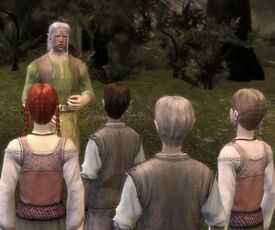
It was free. For over three centuries. But the humans and their new Andrastian Chantry would not let us be. They pushed against our borders. They sent missionaries to spread the word of their prophet. They sought ways to subjugate the People once more. When we refused, we angered them.
They destroyed us. Even the Emerald Knights could not stand against the might of their army, armored in faith. In the name of their Andraste, they burned Halamshiral, scattering us to the winds. They forgot that once, long ago, Andraste's followers and the elves marched together. They forgot that Andraste called Shartan "brother."
—A Promise Lost, as told by Keeper Gisharel to the young hunters of the Ralaferin clan on the outskirts of Halamshiral[4]
Like dragons they fly, glory upon wings.
Like dragons they savage, fearsome pretty things.
—Unknown poet, written of humans shortly before the fall of the Dales[5]
In their new homeland, the elves attempted to rebuild the culture they had lost after generations of slavery in the Imperium and returned to the worship of the Elven pantheon.[6] As they laid the foundations of Halamshiral, the elves vowed that no human would ever set foot on their lands, possibly out of a desire to regain the immortality they believed had been taken from them due to prolonged contact with humans. An elite order of warriors dedicated to the elven gods, the Emerald Knights, was established to ensure the Dales' continued independence.[4]
Relations with humans were strained from the beginning, and only worsened after Kordillus Drakon, first Emperor of Orlais, forcibly unified the disparate cults of the Maker, stamped out belief in other deities, and made Andrastianism the official religion of the newly formed Orlesian Empire. The Dales presented a significant obstacle to Drakon's dreams of expanding Orlais further to the north and to the east.[7][8] Furthermore, elven rejection of the Maker drew the ire of the Chantry,[6] as it confounded their core mission of spreading the Chant of Light throughout Thedas to ensure the Maker's return to the world.[9] The Chantry sent missionaries to the Dales,[7][4] then templars when these were turned away.[10][11]
In response to these human incursions, and after the loss of prominent advocates for closer relations,[12] the Dales became increasingly isolationist, posting Emerald Knights on their borders and rejecting diplomatic and trade overtures.[11][8] When the Second Blight spread across Orlais, the elves refused to lend aid as darkspawn nearly destroyed the nearby human city of Montsimmard.[13] Rumors that the elves sacrificed humans to the elven gods further fueled border tensions.[11][8] An elven attack on the human town of Red Crossing in 2:09 Glory led to open conflict. Accounts differ significantly between human and elven sources. Chantry sources state that the elves attacked the defenseless village of Red Crossing unprovoked and committed atrocities that enraged humans across Thedas while elven sources state that it was an attack made in anger by a small raiding party and point to the Chantry's anger at the rejection of their missionaries.[11][14][15]
By 2:10 Glory, elven forces had captured Montsimmard and were marching on Val Royeaux.[14] In response, Divine Renata I called for a holy war against the elves: the Exalted March of the Dales.[17] While the elves sacked Val Royeaux in 2:14[18] and pushed well into human lands, Halamshiral was conquered and the elves were completely crushed by 2:20 Glory.[19] The Dales were appropriated by the Orlesians, who uprooted elven settlements and forbade worship of the elven gods.[15] Elves who accepted the Chantry's offered truce had to convert to the worship of the Maker and were sent to live in alienages, walled-off slums within human settlements, becoming the city elves.[19]
Some elves, however, refused to give up their worship or their dream of their own homeland. These became the Dalish, retaining the name of their second lost homeland and vowing to keep the elven language, lore and religion alive.
The Fifth Blight
While some contemporaries dispute whether the Fifth Blight was a true Blight or merely a large darkspawn resurgence, historians agree that it began in the swamps of the Korcari Wilds on the southeastern border of Ferelden in the year 9:30 Dragon.
King Cailan Theirin was swift in responding to the threat of encroaching darkspawn, gathering the royal army, every Grey Warden in his country, and sending a call for aid to the Fereldan nobility. The assembled armies laid a trap in the ruins of Ostagar, hoping to crush the force before it reached civilization, but they failed.
Darkspawn overran the defenders of Ostagar and decimated the king and his army. They continued their advance into Ferelden unopposed. Only two Grey Wardens managed to escape the slaughter. And somehow, they came into possession of ancient treaties, which compelled the races of men to join arms against the massing horde.
In desperation to find more allies, the Wardens journeyed into the Brecilian Forest, seeking the Dalish.[20]
When the Warden finds the Dalish elves, the Warden discovers that they are being destroyed by a virulent disease which is turning them all into werewolves. The clan keeper, Zathrian, asks the Warden's assistance in ridding them of the curse. He requests that the Warden find the first werewolf, Witherfang, and return with his heart to end the curse destroying his people. The quest takes the Warden through the Brecilian Forest to track down the lead werewolf.
If the Warden sided with the elves in "Nature of the Beast", the Dalish elves, too, will join the Grey Warden's growing army.
- At the end of Dragon Age: Origins, it is possible for the Hero of Ferelden to ask the new monarch of Ferelden to grant the Dalish their own lands if the Warden is of Dalish origin. Specifically the Hinterlands north of the Korcari Wilds, which includes the ruins of Ostagar. Alternatively, if the Warden is of Dalish origin and sacrifices themself to end the Blight, the Dalish will be given these lands. If Dalish elves participated in the Battle of Denerim and were gifted the land boon, it states that in time, many of the Dalish clans moved to new land provided for them in the south of Ferelden near Ostagar. The epilogue will then reveal that they settle these lands, though new political tensions arise.[21] This outcome was later changed to accommodate the storyline of Inquisition, where humans populate the Hinterlands instead of the Dalish.
Culture and clan life

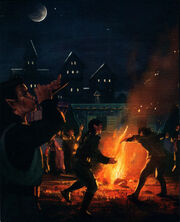
“You were born amidst the Dalish elves: noble wanderers who refused to join the society of humans that subjugated their homeland so long ago. The Dalish travel the lands in tightly-knit clans, struggling to maintain their half-forgotten lore in a human world that fears and despises them.” ―Duncan at the beginning of Dalish Elf Origin
The Dalish travel around the more remote reaches of Thedas in aravels, special wagons with large triangular sails and rudder-like devices on the back. In addition to being pulled by Halla, aravels use magic to move through the forests quickly and easily.[23] While travelling, they carry their children in padded slings.[24]
The Dalish are familiar with many natural remedies humans have forgotten or ignored, such as chewing pieces of bark from certain trees to cure a headache.[25]
For food, the Dalish rely mostly on hunting and foraging. Their diet also includes halla milk and related dairy products such as butter and cheese.[26][27][28] The elves of southern Orlais eat the larvae of a wood-burrowing beetle.[29] Like many Thedosian cultures, the Dalish also make use of preserved and dried foodstuffs such as jerky during lean periods, seasonal changes, and other times of scarcity, as well as on long journeys. Dalish hunters take spiced jerky with them as provisions when away from the clan on the hunt, to stave off their hunger, ensure that their hunt is successful, and prolong the period in which they are able to be away from camp. Owing to how long it lasts, it is speculated that some Dalish elves may leave spiced jerky as offerings at shrines of Fen'Harel.[30] The Dalish commonly eat hearth cakes as a comfort food. These are made from halla butter, halla milk, flour, eggs, sugar, cinnamon, nutmeg, ginger, and fine-ground salt. Hardwood ash is incorporated as a leavening agent. They are traditionally baked upon the hearth on a skillet or iron griddle, which gives the dish its name. They can be made plain or studded with whatever dried fruit is on hand, such as currants, raisins, and cranberries.[31][32] The Dalish also make warm forest fruit cobbler using various in-season forest fruits.[33] Dalish elves throughout Orlais eat peasant bread, a simple and humble biscuit made from approximately equal parts of grease, wheat, and salt.[34][35] It is topped with sugar[36], butter, and jam but can also be used with stew.[37]
Certain roles among each clan are stringent and clearly defined in all the clans depicted so far. A keeper serves as a leader and spiritual guide, and working in tandem with them is a storyteller hahren (elder) who reiterates the Elven lore and tends to the children. Other important positions are being the designated warleader, hearthkeeper and craftsmaster. There is also a designated Halla Keeper, the master herder in charge of caring for the halla.[38] Elves can also be a Hunter, Warrior, Crafter or a Healer, or presumably occupy multiple less-demanding roles. Each position has an apprenticeship stage, an example being how an elf must kill and present a beast of the forest all by themselves to become a fully-fledged hunter.[39]
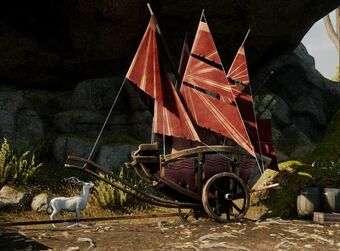
Whilst they still lived in the Dales, the Dalish had at least one Lord called Hassandriel in 2:7 Glory, towards the end of the elven nation.[40] It was in essence based on an aristocratic/oligarchic model rather than simply a monarchy.
Along with their telltale aravels, the Dalish elves are also known for being the only race capable of forging ironbark, a unique substance stronger and lighter than steel, used to make their weapons and certain other items of clothing. For a typical hunter's armor, ironbark plates are combined with leather. The material can also be enchanted.[41] For weapons, Dalish use daggers, arrows and nets. Ironbark weapons, along with carved halla horns, are highly valued and are used to trade with humans for things they cannot make on their own.
Dalish elves tend to keep to their own and avoid humans whenever they can, but will occasionally encounter human travelers, or venture near human settlements to trade. At the threat of these encounters becoming violent, a Dalish clan will likely withdraw before any real force of humans gets involved, but they will often still be willing to stand their ground. In the long run, hostilities with humans will likely end badly for the elves, especially if a human settlement decides that a certain clan has become more trouble than it is worth.
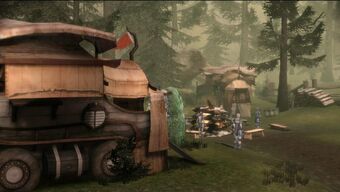
The Dalish clans themselves can also be quite different from each other. Some clans will get along fairly well with humans, and might even camp outside of settlements for long periods of time. Other clans are more infamous, living by banditry and hiding like guerrillas in the mountain passes. In particular, the Dalish clans in Antiva are said to be more secretive and violent than the rest.[42] They often build "forest marionettes" that are mistaken for sylvans or unquiet spirits to scare humans away from their clans.[43]
Vallaslin
- See also: Vallaslin
When the children of our people came of age, they earn the privilege of wearing the vallaslin, the blood writing. It sets us apart from the shemlen, and from the elves who have thrown their lot in with them. It reminds us that we will never again surrender our traditions and beliefs.
The ritual deserves great reverence. The one who is to gain the vallaslin must prepare by meditating on the gods and the ways of our people, and by purifying the body and the skin. When the time comes, the keeper of the clan applies the blood writing. This is done in complete silence. Cries of pain are signs of weakness. If one cannot tolerate the pain of the blood writing, they are not ready to undertake the responsibilities of an adult. The keeper may stop the ritual if they decide that the one gaining the vallaslin is not ready. There is no shame in this, for all children are different, and our ancestors once took centuries to come of age.
—As told by Gisharel, Keeper of the Ralaferin clan of the Dalish elves.
Marriage
- See also: Sexuality and marriage
The Dalish version of marriage is referred to as 'bonding'.[44] Dalish vows are said in elvish. One version is "Sylaise enaste var aravel. Lama, ara las mir lath. Bellanaris."[45]
Funeral
- See also: Funerary rites
When Dalish elves die, their clan will bury them and plant a tree over their remains.[46] The dead are provided with an oak staff to help them along the path of the afterlife, and a cedar branch to scatter the ravens of Fear and Deceit who were once servants of Dirthamen.[47] If a clan is able to, they will bury their dead in a sacred burial site known as Var Bellanaris, which is located in the Exalted Plains.
Lore-keeping and education
- Main article: Education
“In time, the human empires will crumble. We have seen it happen countless times. Until then, we wait, we keep to the wild border lands, we raise halla and build aravels and present a moving target to the humans around us. We try to keep hold of the old ways, to relearn what was forgotten.” ―Gisharel, Keeper of the Ralaferin Clan[48]
Both the Dalish and city elves have an oral tradition in which much of their knowledge and tradition is passed along, but never actually written down.[49] Lanaya states that the Dalish believe that one day, the elves will have a land of their own; when that day comes, all elves—even those who have forgotten—will reclaim their former glory. The Dalish intends to return the old ways to the elves who have lost them once they have established a new homeland.
The Dalish clans gather the ancient wisdom in preparation for this; the clans also stay apart from one another in order to survive and preserve their culture.[50] Hahrens instruct through the use of lore and storytelling. However, there are some books to preserve history, few and precious.[51] Children are highly valued among the clans.
Dalish clans rarely encounter each other in order to protect themselves; their diaspora is as much of a blessing as is a curse. Only once every decade or so do the Dalish clans all meet together, and their keepers, the elders and leaders of the Dalish who are responsible in keeping elven lore and magic alive, will meet together and exchange knowledge in a meeting called the Arlathvhen.
During such a time, the clans will recall and record any lore they have relearned since the past meeting, along with reiterating what lore they know already to keep their traditions as accurate and alive as possible. During such time, the clans will exchange relics dating from the two elven nations for safekeeping. The Dalish believe that all the relics they've preserved from the Dales and Arlathan belong to all the Dalish; such trades are seen as much of an act of sharing as it is a matter of trade, and the same is true even for talented elves. Merrill, for example, was born in the Alerion clan, but due to her magical talents she was given to the Sabrae clan to be the First of Keeper Marethari as clan Alerion already had a number of gifted elves.
A clan's "First," an apprentice mage under a Keeper, studies history and magic and attempts to preserve elven lore.[52] As magic becomes more rare among the Dalish, children with the gift of magic may be moved between clans to ensure than every Keeper has a successor.[53]
The Dalish believe it is their responsibility to relearn the old ways of their ancestors. However, their knowledge of the old elven culture is patchwork from what little they could salvage themselves; what knowledge of the old ways they do know has taken them lifetimes to achieve.
The Dalish have tried to preserve the ancient elven culture by remembering stories of their history. What techniques or philosophies their ancestors utilized that are still applicable in serving the needs of the clan are taught as trades for Dalish members. This has brought about specialized roles in Dalish clans that not only bears the responsibility of learning everything they can about their aspect of Dalish culture, but also serves to help sustain the clan in their new way of life. For example, a clan craftsmaster's duty is to learn what they can of the ancient elven arts of shaping wood and ore, while a hunter may learn ancient elven knowledge that protect and provide for the clan. Whatever their role, the Dalish use their talents and knowledge to address the needs of the clan.
The Dalish take on apprentices from the younger generation of their clan to pass on their knowledge and continue the legacy of their ancient arts. The apprentice appears to graduate their apprenticeship after passing a test of competence when their mentor and Keeper deems them ready. Graduation from apprenticeship also seems to be a rite of passage to adulthood in Dalish clans.[39]
Philosophy
Many Dalish live by goddess of the hunt Andruil's code known as the Vir Tanadhal, meaning "Way of Three Trees" or "the Ways of the Hunter." It is made of three parts, taught by Andruil herself, which are:[54][55]
- Vir Assan ("Way of the Arrow") - fly straight and do not waver. "Be swift and silent," Andruil taught. "Strike true; do not waver. And let not your prey suffer."
- Vir Bor'Assan ("Way of the Bow") - bend but never break. "As the sapling bends, so must you. In yielding, find resilience; in pliancy, find strength."
- Vir Adahlen ("Way of the Forest" or "Way of the Wood") - together we are stronger than the one. "Receive the gifts of the hunt with mindfulness. Respect the sacrifice of my children. Know that your passing shall nourish them in turn."
The three parts of the philosophy are often strung together as a sort of mantra, which the Dalish will often end with the phrase, "We are the last of the elvhenan, and never again shall we submit." A rite of passage for hunters is to bring back the pelt of a creature the hunter has killed.[56]
Seldom spoken of, however, is a fourth way: the Vir Banal'ras, the "Way of Shadow." Dalish hunters assume it when a debt of blood must be repaid. Such hunters dedicate themselves to vengeance and nothing else. Thus were born the legends of Dalish assassins.
A few follow a different path, Sylaise's code known as Vir Atish'an, "The Way of Peace": Dalish following this calling learn the arts of the healer and the mender.[57]
When dealing with one another, Dalish elves may invoke Vir Sulevanan, a bargain by which an elf will complete a given task for another in return for something, such as a valuable clan item. By invoking this, any Dalish can essentially perform a service for a clan and gain ownership of such an item for a period of time. Though the recipient of this bargain may dissent, they cannot reject an offer of Vir Sulevanan. Similarly, the elf offering the bargain must apparently agree to the task set to them whether it is desirable or not.[58]
Naming customs
Clans are named for the nobles from the Dales who originally founded the clan. Every Dalish surname preserves a lineage from someone, though not necessarily a clan founder. One noble clan founder could start a clan with some Emerald Knights, who would also pass on their names (e.g. clan founder Sabrae with Emerald Knights Mahariel and Talas). As the Dalish often trade people between each other, not everyone in a given clan is a descendant of its founder, and as such doesn't necessarily bear their name.[59]
Known Dalish clans
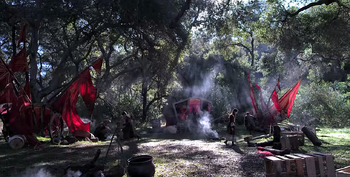
- Alerion – the clan Merrill was born into
- Boranehn – a clan that traded with Edgehall's alienage;[60] the clan Vaea's uncle Coran joined; They make a summer rest in the woods near the town of Edgehall
- Ersallae – a clan whose First and Second, Saeris and Taeryn, went looking for mysterious circles.[61]
- Ghilain – a clan that descends from Inquisitor Ameridan[62]
- Lavellan – the elven Inquisitor's clan
- Morlyn – the clan of Strife of Arlathan Forest[63]
- Nuvenis - a clan in Ferelden[64]
- Oranavra clan – on the Nocen Sea coast[65]
- Ralaferin clan – whose Keeper in 9:41 is Elindra (formerly Gisharel); whose First is Neria[66]
- Sabrae – the Dalish Warden's clan and the one Merrill was transferred to
- Tillahnnen – once headed by Keeper Ellathin[67]
- Virnehn – the clan of Thelhen and Mihris
Unnamed Dalish clans
- Ariane's unnamed clan
- Fanora's unnamed clan – known for sending Hall away when he was grown[68]
- Hawen's unnamed clan – located at the Dalish Encampment on the Exalted Plains
- Iloren's unnamed clan – located in the Anderfels during the Second Blight[69]
- Minaeve’s unnamed clan – known for sending her away as there were too many mages within the clan
- Sendis' unnamed clan – the Legends Hero encounters the clan in Dragon Age Journeys
- Shirallas' unnamed birth clan
- Shirallas' unnamed adoptive clan
- Velanna's unnamed clan – located in the Wending Wood
- Yevven's unnamed clan – massacred by one of Arishok's Saarebas whilst staying in the Free Marches
- Zathrian's unnamed clan – located at the Dalish Camp in the Brecilian Forest
- Unnamed clan that found young Loghain and Maric in the Korcari Wilds
- Unnamed clans on the Waking Sea coast[70]
- Davrin and Eldrin's unnamed clan
- Bellara and Cyrian Lutare's unnamed clan
Notable Dalish elves
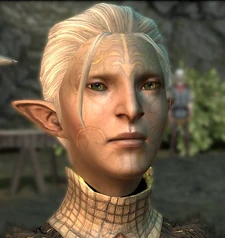
- For a complete list, see Category:Dalish.
- Abelas – a luckless Dalish woodworker[71] (Not to be confused with Abelas from Dragon Age: Inquisition.)
- Ariane
- Arianni
- Ashalle
- Cillian
- Gisharel
- Ilen
- Inquisitor Lavellan – if they are the sole survivor of the Divine Conclave
- Josmael
- Lanaya
- Lindiranae – the last wielder of Evanura; her death marked the end of the Exalted March
- Marethari
- Merrill
- Mihris
- Neria
- Rajmael – a Dalish general during the Exalted March against the Dales[72]
- Sarel
- Seranni
- Solan – Keeper of Ariane's clan[73]
- Strife
- Tamlen
- Varathorn
- Velanna
- Yevven
- The Warden / The Warden-Commander – if they originated from the Dalish Elf Origin
- Zathrian
Codex entries
 Codex entry: The Dalish Elves
Codex entry: The Dalish Elves Codex entry: Aravels
Codex entry: Aravels Codex entry: The Dales
Codex entry: The Dales Codex entry: The Dales: A Promise Lost
Codex entry: The Dales: A Promise Lost Codex entry: The Exalted March of the Dales
Codex entry: The Exalted March of the Dales Codex entry: Halla
Codex entry: Halla Codex entry: Halla
Codex entry: Halla Codex entry: The Long Walk
Codex entry: The Long Walk Codex entry: The Long Walk to Halamshiral
Codex entry: The Long Walk to Halamshiral Codex entry: Vallaslin: Blood Writing
Codex entry: Vallaslin: Blood Writing Codex entry: Vallasdahlen
Codex entry: Vallasdahlen
Notes
- Several characters in Dragon Age: Inquisition claim that Dalish clans limit the number of mages in any one clan to three: a Keeper, First, and Second.[74] As this restriction is not mentioned by Zathrian's clan nor the Sabrae clan in Dragon Age: Origins and Dragon Age II, it is unknown whether this limitation is common among the Dalish, or is something that occurs only in specific clans.
- According to David Gaider, Dalish in Rivain have a semi-permanent settlement on the outskirts of the city of Llomerryn.[75] However, party banter during Act 2 in Dragon Age II between Isabela and Merrill suggests that the Dalish have not yet reached Llomerryn (at least since Isabela was last there).
- It is unknown whether or not Dalish elves live longer than the city elves, since David Gaider and Mary Kirby have given conflicting information regarding their longevity.[76][77]
- Dalish clans in the Tevinter Imperium are said to be more like groups of bandits. However, Dorian Pavus notes that Dalish do not really come to Tevinter at all, for obvious reasons.
Trivia
- David Gaider said that the original inspiration for the Dalish came from the Roma and Jewish people, and then it evolved into North American Natives.[78] Years later, Patrick Weekes said the actual details of the cultures in question are explicitly different and no one-to-one comparison can be drawn.[79]
- Young Dalish elves are given wooden puzzles called "June's knot," that have no solution to occupy their time.[80]
- Some Dalish look down on the "flat-ears", the City Elves who live trapped in poverty and high walled Alienages amongst the shemlen—the humans or "quick children". Other Dalish have a more amicable relationship with city elves. They are willing to welcome city elves like Pol and even induct them into their Dalish clan if the city elf desires it. Keeper Marethari is also welcomed and held in great esteem in the Kirkwall Alienage so relationships between Dalish and city elves do vary.
- Every Dalish clan is sworn to protect its Keeper to the death, and should the Keeper fall to demonic possession, the clan is bound to hunt and slay the Keeper.[81] Even if the Dalish have methods to drive out a demon from a Dalish mage, the ritual would leave the soul of the mage scarred and easy prey for scavengers.[82]
- The elves of the Dales were experts in the somniari arts. They were even able to help those with no power (i.e., non-mages) enter the Fade through a magical ritual. The Dalish, such as Keeper Marethari Talas, knows of such a ritual. Marethari states she learned of the ritual from the Tome of the Slumbering Elders.[83]
Gallery
References
| ||||||||||||||||||
